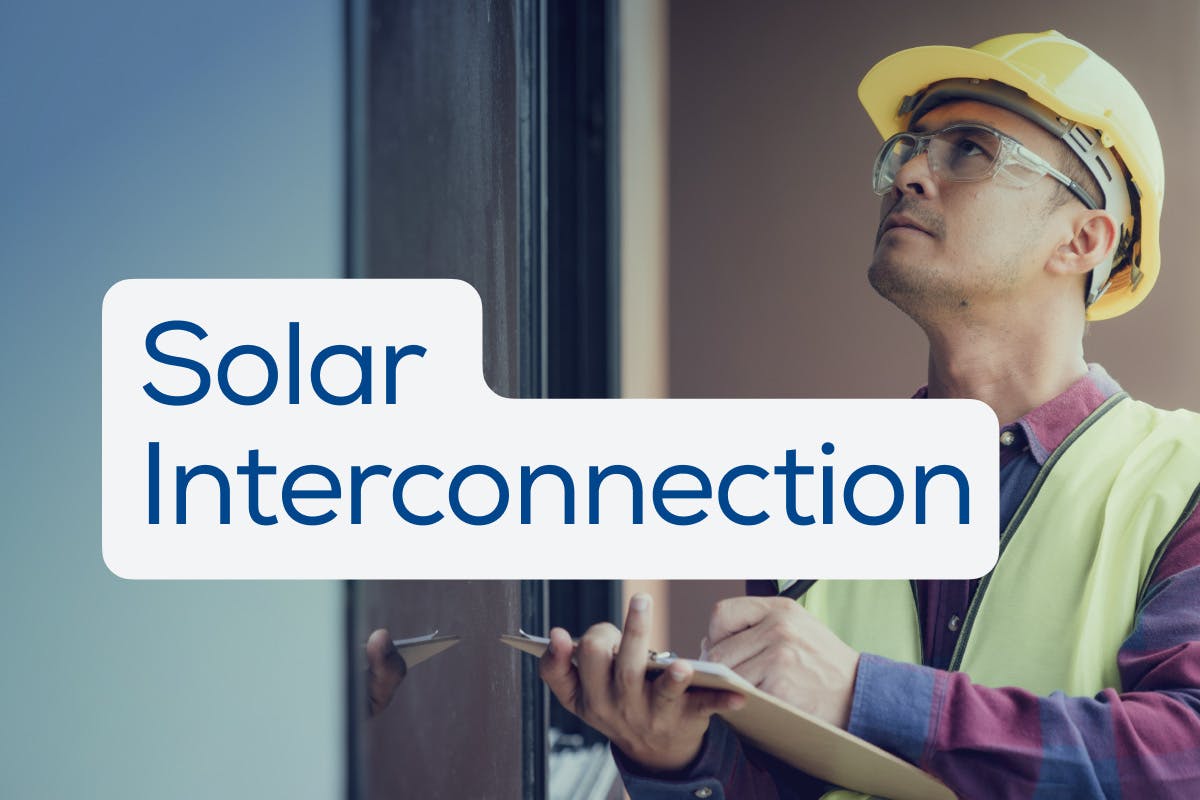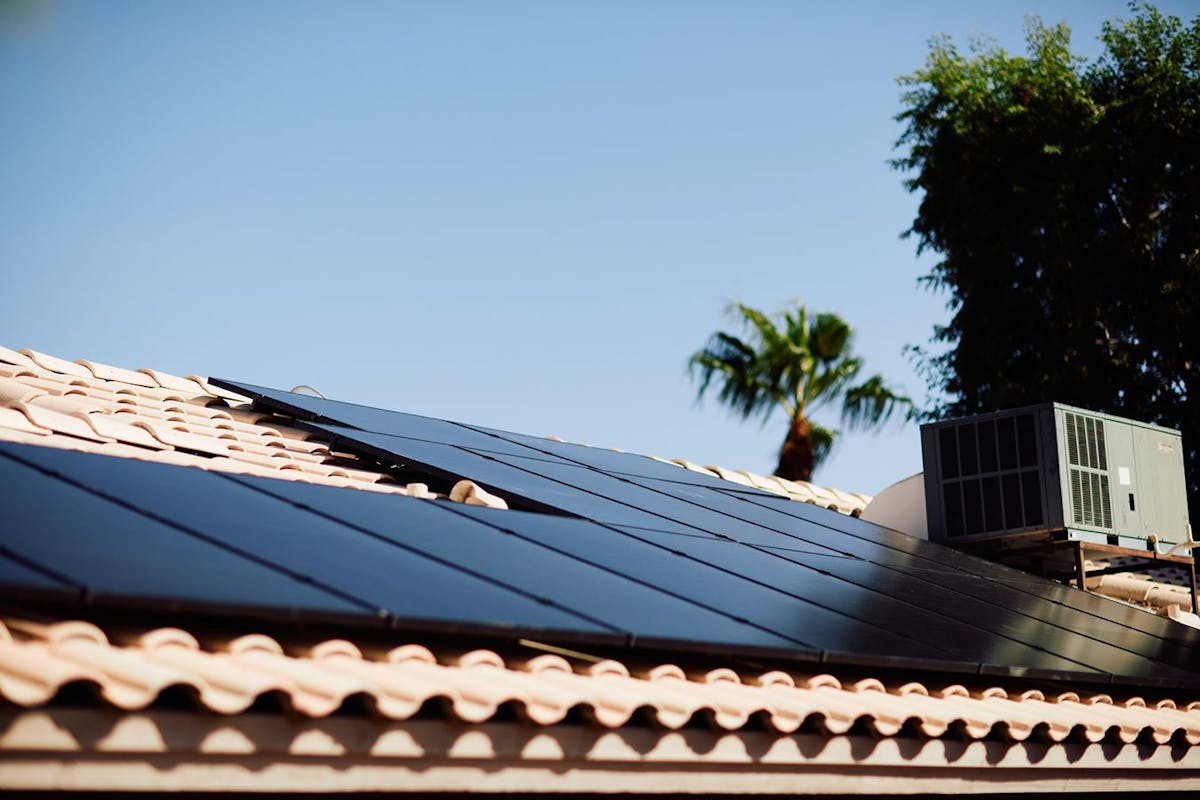How Solar Panels Get Connected to the Grid: The Utility Interconnection Process
Last edited

Author
Andrew Giermak
Solar and Electrification Writer and Editor

Editor
Andrew Blok
Electrification and Solar Writer and Editor

Investing in going solar for your home’s electricity is a big decision. So when your new home solar panels are being installed, and you’re moving toward flipping the switch to solar energy, you deserve to have the process go smoothly.
The utility interconnection process is a critical — if not so exciting — part of getting your new system up and running. The right solar team will take care of getting the right permission and permits for your solar system to connect to the larger electric grid. Here’s what you need to know.
See how much you can save by going solar with Palmetto
What Is Interconnection?
Interconnection is the process by which a solar customer applies for and receives permission from the local utility company to connect to the utility grid.
If you’re working with a professional solar company like Palmetto, they will likely take care of the interconnection process on your behalf. That said, it’s still helpful to understand what’s happening during this step in the solar installation process.
What Is the Interconnection Process?
Receiving approval from your utility provider is required to connect your solar power system to the utility grid so your solar panels can start generating electricity for your home and earning net metering credits (if available). Most commonly, the solar interconnection process is separated into two key processes: permission to install, and permission to operate. Some utilities require only a permission to operate and do not require permission to install.
While the specific steps may vary by utility company, the overall goal is the same: Ensuring your solar energy system is properly designed and installed, so it’s safe for your home and the electrical grid.
At the same time, any Authority Having Jurisdiction (AHJ - the local building department that controls your area) must approve significant construction projects, including solar energy system installations. Therefore, your solar company will apply for permits while also pursuing interconnection to help speed up the timeline. You can read more about this process at How Local Solar Permitting Impacts the Cost of Your Solar Panels.
Permission to install
If your utility requires you to request permission to install as part of the interconnection process, your solar company will submit an application to your utility provider to review the electrical plans, equipment specifications, and overall system design. Their goal is to ensure the electrical equipment meets all applicable standards for interconnection.
Steps for conditional interconnection approval
- Your solar company submits an interconnection application to your utility company for permission to install, which may include:
- Your signature as the utility account holder on all relevant documentation
- The engineering plan set for your solar power system
- Homeowners’ insurance, supplemental documentation, and additional engineering documentation may also be required, depending upon local requirements
- The utility company reviews the application for accuracy and adherence to interconnection standards.
- The utility company verifies grid capacity is available and confirms that all engineering specifications meet utility standards.
- If all requirements are met and grid capacity is confirmed, the utility will issue approval to install.
Between steps 2 and 4, the application can be kicked back by the utility company. If this happens, your solar contractor must make corrections or provide additional information before approval can be granted.
See how much you can save by going solar with Palmetto
Permission to operate
After your system has been installed and passed all required inspections, your solar contractor will begin part two of the interconnection process, often referred to as submitting permission to operate, or PTO. While permission to install requires a review of the installation plans, permission to operate requires a review of the completed installation.
Steps for permission to operate
- Your solar company submits a ‘Part 2’ interconnection application to your utility company for permission to operate, and it may include:
- Installation photos
- Passed inspection documentation
- Part Two Interconnection documentation
- Your signature on relevant documentation
- Any additional supplemental information your specific utility may require
- The utility company reviews your solar power system, checking for any issues. Some utilities send their staff to your home for an on-site inspection, while others may approve virtually based on installation photos. If the solar equipment is located outside, you may not need to be home during this step, but if the inverter or AC disconnect is in the garage, you will likely need to be home to allow utility staff access.
- If the installation does not meet utility requirements, the solar contractor will make adjustments and then re-apply for PTO.
- During the installation process, the utility will ‘reset’ or ‘swap’ your electric meter to a bi-directional meter that can accurately measure kilowatt-hours (kWh) flowing from the grid to your home, and excess solar energy production your home does not use that flows to the grid.
- Once your solar energy system receives permission to operate, you can activate your system and begin generating electricity.
Common reasons PTO for a solar energy system might be rejected include:
- The inspector needs to call the utility to confirm the inspection was passed.
- The customer’s utility company account has issues or has a hold.
- The system failed the utility company’s inspection.
Interconnection Timeline and Cost
The interconnection process for residential solar can take anywhere from two to four weeks on average, depending on your utility company and system size.
The cost for interconnection can depend on your utility, your home’s location in relation to the electric grid, and your solar system size. For most homeowners, this ranges from no cost to about $200, and it will be included in the total cost of your system.
The Importance of Interconnection
Clear and defined interconnection processes are essential for public safety. Utility companies need to review every interconnection to the grid so people, property, and systems are kept safe and secure.
Solar power systems that are connected to the grid are designed to shut down automatically during power outages to ensure solar electricity does not harm utility workers. Solar power systems with battery storage can be designed to continue producing solar electricity while ensuring that all excess production is stored in the battery and not sent to the grid during power outages. (This is known as solar islanding.)
During the interconnection process, the utility verifies that the safety measures necessary to connect your solar power system with the grid are in place and working. It also sets your electric bill up for net metering if available.
Your solar company should employ interconnection specialists who stay up to date with current processes for every utility company they work with, ensuring a smooth interconnection process.
Interconnection Is Essential to Your Solar Power
It’s important to have your planned installation and your completed installation reviewed so everyone is kept safe when your system is connected to the utility grid.
Processes, timelines, and requirements will vary by utility company, but working with a solar company like Palmetto will ensure the process runs smoothly. Before you know it, your solar panels will be generating clean energy and reducing your bills.
If you want to learn more about getting solar panels installed on your home, talk to Palmetto today. You can get started with our free solar savings calculator to see how solar panels might look on your roof and how much you could save.
See what solar can do for you:
Frequently Asked Questions
What is utility interconnection?
The utility interconnection process is how a solar power system is permitted to get connected to the utility company’s electric grid. Interconnection is a critical safety step and allows a new system owner to send solar-generated electricity to the grid and use grid power when needed.
What does permission to operate mean?
Once a new solar power system has been installed and passed inspections, you must get permission to operate before using the system. Permission to operate is your area’s utility company’s review of the completed system.


